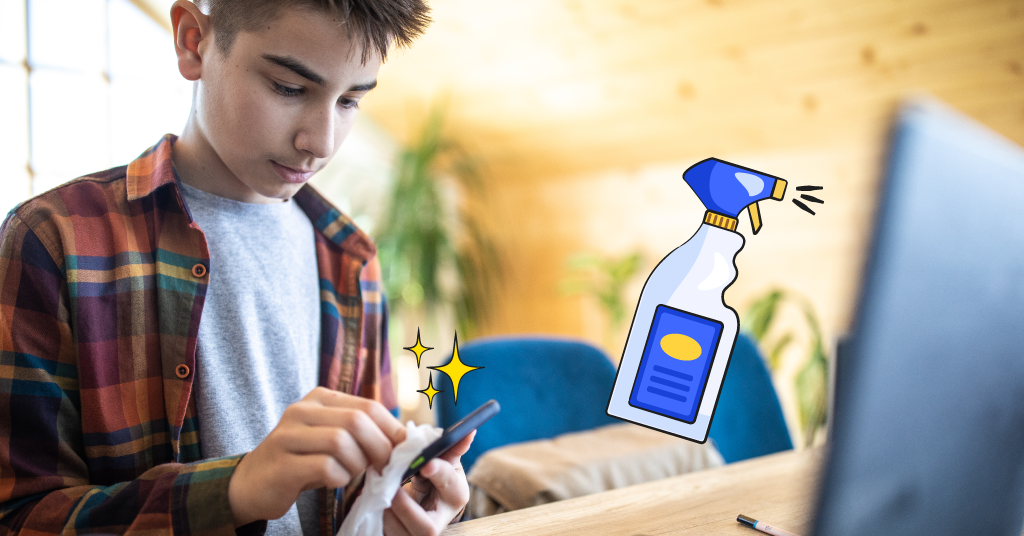For much of human history, raising kids meant teaching important life skills like reading, cooking, interacting in the world, and how to be a good person. Children learn a lot of these things by simply watching their parents day in and day out as they grow up.
In the past decade though, a new task has been added to our digital generation: modeling healthy screen time habits. Phones and devices have quickly become an absolute necessity in our society, and though kids are usually eased into them, it’s important for young people to learn how to use them responsibly and in a healthy way. There’s no better way for parents to instill these values than by setting a good example to follow.
In this post, we’ll give you some ideas on how to model healthy screen time habits.
How Much Screen Time Is Healthy?
The short answer for this one is that it totally depends. Your child’s age, your level of busyness, whether your traveling for vacation or it’s a regular school week — all these are factors that affect how much screen time your child may or may be getting. Less is better than more, of course, but one-off days are bound to happen and don’t mean the end of the world.
Here’s what the American Academy of Pediatrics (AAP) recommends by age to help you answer the question of how much screen time is healthy:
Toddlers
Limit screen time to less than one hour per day.
2 to 5 years
Limit screen time to one hour per day (three hours on weekends) of high-quality programming, and watch it together to help them understand what they are seeing.
6 years and older
Make consistent limits on the amount of time spent on devices and watching screens, and ensure screen time doesn't interfere with adequate sleep, physical activity, and their social life. Screen time habits are super important as you head into the teenage years. The older kids get, the more they’ll need screens to communicate, do school work, get driving directions, and more.
Ways Parents Can Model Screen Time Habits
Deprioritize your phone
We know — this one’s going to be easier said than done, especially if you’re a working parent with a demanding job. And sometimes you’re going to just need a phone break to decompress. It’s okay! We all do.
But there are small ways you can silently show your child that your life doesn’t completely revolve around checking work emails, scrolling Instagram, and shopping on Amazon.
- Try not keep it in your hand all of the time
- Don’t always instantly reach for it whenever there’s a quiet moment (like during a commercial or standing in line at the bank)
- If you’re on your phone when your kid asks a question, set it down and look your child in the eye when you respond. (This applies to the first 5 questions — we know that kids can ask a lot of questions sometimes).
- Manage your notifications by turning off non-urgent alerts, like for social media.
Keep certain times sacred
This goes for yourself as well as your children — designate daily times when phones are to be left behind. Think dinner time, the hour before bed, or on the commute to school. When you create these tech-free periods, you’ll notice more opportunities for meaningful conversations and undistracted family bonding.
Demonstrate balance between real-life & digital activities
There’s no denying that screens are important to modern life and that they can be useful, informative, and entertaining. But there’s more to life than digital engagement, and you can set a good example for your kids by having non-screen-related hobbies and activities you enjoy. Make sure your family knows how important things like reading, exercise, gardening, sports, volunteering, and other pursuits (anything you love, really!) are to a healthy life.
Create tech-free zones in the house
One of the most important things we stress to parents here at Bark is that there are no good reasons for kids to have screens in bedrooms or bathrooms. You could even make up your own rules, too — like no devices in the family room on movie night. This just helps make the time you spend together more deliberate and distraction free as you build up healthy screen time habits.
Struggling with Screen Time Limits? Bark Is Here to Help
Talking about healthy screen time habits is one thing, but actually implementing them is a whole other beast. Fortunately, there’s technology that can help, and Bark is your best option!
We have robust screen time controls that actually work (looking at you, buggy Apple Screen Time). After all, different times of day call for different rules, which is an important part of creating healthy screen time habits. A schedule that works for your family could look like “No YouTube during the school day” or “Only music apps after bedtime.” You can even make different schedules for each child and every device!
Bark’s screen time scheduling is an important part of our product, but there’s so much more that comes with it. You can also track location and block websites and apps, but it’s Bark’s content monitoring that makes it an absolute game-changer when it comes to online safety.
Bark scans your kid’s social media accounts, texts, emails, and files for potential issues. If something concerning is found — like sexting, online predators, bullying, and depression — you’ll get an alert so you can check in and make sure everything’s okay.
Start your free, 7-day trial today, or learn more about the Bark Phone, which is our phone designed specifically with parents in mind that comes with Bark built in, along with a host of cool features like contact approvals, daily time limits, and much more. Goodbye stress and hello healthy screen time habits!
Read more
Bark helps families manage and protect their children’s digital lives.






